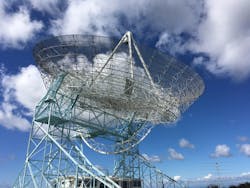SRI International to conduct high-power RF and microwave experiments for space with Stanford dish antenna
WASHINGTON – U.S. Navy researchers needed a company to conduct experiments in low-frequency high-power RF and microwave signals for airplanes and spacecraft. They found their solution from SRI International in Menlo Park, Calif.
Officials of the Naval Research Laboratory (NRL) in Washington have chosen SRI to conduct research experiments with the NRL-owned Bluestar 150-foot RF and microwave antenna located on the campus of Stanford University in Palo Alto, Calif.
SRI experts will conduct low-frequency high-power RF experiments with the Bluestar antenna to take research into the next phase of RF exploration for space and aircraft where power levels will be pushed to maximum to determine what the antenna can produce.
The Bluestar antenna, known at Stanford as The Dish, is a 150-foot-diameter radio antenna was built in 1961 by the Stanford Research Institute (now SRI International). In the 1960s the antenna provided information on Soviet radar by detecting radio signals bounced off the moon.
SRI will conduct research into defining RF signals; setting signal parameters into pulse descriptor words for custom-designed equipment; designing algorithms to help generate RF signals in low bands; and implementation of those algorithms into software executables.
Custom-designed hardware will execute the software. The contractor must have an access or right-to-use agreement with Stanford University to gain access to the system.
SRI experts will use satellite and aircraft calibration techniques using the large antenna; test and measurement equipment; satellite communications on this project.
The Bluestar antenna also has been used to communicate with satellites and spacecraft with its unique bistatic-range radio communications, in which the transmitter and receiver are separate units. The antenna was suited for communicating with spacecraft in regions where conventional radio signals can be disrupted.
In its 63-year history the Bluestar antenna also has transmitted signals to each of the Voyager spacecraft that NASA dispatched into the outer reaches of the solar system, and helped rescue the amateur radio satellite UoSAT-1.
For more information contact SRI International online at www.sri.com, or the Naval Research Laboratory at www.nrl.navy.mil.
